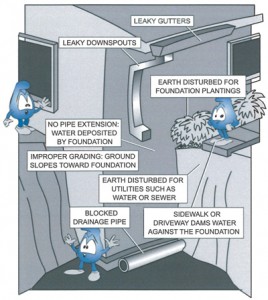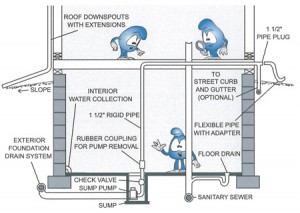Inflow and Infiltration
Progress Report
Why is the City inspecting properties?
The City of Foley has been inspecting properties for clean water entering into the sanitary sewer collection system. This process is a part of the City’s I&I (Inflow & Infiltration) project to help the City find solutions to the problem of the sanitary sewer collection system reaching its capacity.
The capacity problem of the system is in part related to “clean” water, storm water and groundwater, entering the system. Inflow refers to rainwater entering the sewer system via storm water drains or sump pumps, and infiltration is groundwater entering into the sanitary sewer system through defective pipe joints and cracked pipes.
The inspections help find and eliminate the sources of excessive flows into the wastewater treatment system causing the City to be out of compliance with the terms and conditions of the license and regulations set forth by the MN Pollution Control Agency. The MPCA has issued a license to continue the operation of our wastewater treatment ponds provided the City follows very stringent mandated regulations set by the MPCA. Failure to comply with these mandates will cause the City’s license to be revoked. If the problem is not resolved, City residents could incur a great expense by having to install a new wastewater treatment facility.
Inspections look at how sump pumps, roof downspouts, foundation drains, and pipes are connected to the sewer line flowing from your building to the City’s sewer main in the street. Inspection technicians from the city’s contracted engineering and consulting firm of Short Elliot Hendrickson, SEH, Inc, conduct the inspection. The result of the inspection will determine if any corrective work or repairs need to be done. Any necessary corrective repairs will need to be completed by December 31, 2015. Properties not in compliance after that date will be assessed $75.00 per month on the quarterly utility bill until compliance is met.
The City Council is working with the Small Cities Development Program (SCDP) and Tri-CAP to acquire grant funding to assist the resident with the cost of any necessary corrective repairs. Please contact the City Administrator at 968-7260 for more information or if you wish to be put on the list to receive funding.
The Problem
 Sump pumps and foundation drains are designed to eliminate wet basements due to ground-water seepage. Throughout the Midwest, residential and commercial properties have been built with a piping system around the foundation to collect this water and take it away from the property. Additionally, roof leaders are sometimes connected into this piping system as well.
Sump pumps and foundation drains are designed to eliminate wet basements due to ground-water seepage. Throughout the Midwest, residential and commercial properties have been built with a piping system around the foundation to collect this water and take it away from the property. Additionally, roof leaders are sometimes connected into this piping system as well.
When this piping system is connected to the sanitary sewer system, it adds a tremendous amount of stormwater into the system. This is storm water that does not need to be treated by the Wastewater Treatment Plant. In addition, the sanitary sewer system was not designed to handle this storm water. During times of high groundwater or heavy rainfall, the sewer system becomes overloaded and basements flooding or bypassing of raw wastewater to local streams may occur. This is not only an inconvenience but a health hazard, and an additional expense to all the citizens of the community. Excess water overloads pumping facilities and the Wastewater Treatment Plant, making the cost of treating sewage much more expensive. The cost is passed on to all members of the community.
The Solution
 We all need to pitch in and reduce the amount of water we put into the sanitary sewer system. Here’s how we can fix the problem.
We all need to pitch in and reduce the amount of water we put into the sanitary sewer system. Here’s how we can fix the problem.
SUMP PUMPS – pump the storm water from the sump directly to the ground outside of the building using a rigid piping system.
FOUNDATION DRAINS – disconnect the drain system from the sanitary sewer. Collect the drains into a sump pump system and then pump the storm water from the sump directly to the ground outside of the building using a rigid piping system.
ROOF LEADERS – disconnect the roof leader from the connection to the sanitary sewer and discharge to the ground outside of building. Plug any open connections to the sanitary sewer using anon-shrink permanent material.
